By Susan Barton
This article was excerpted and adapted from a Delaware Cooperative Extension Brochure entitled Livable Plants for the Home Landscape | Cooperative Extension with the permission of the author.
In today’s rapidly urbanizing environment, we have a unique opportunity, if not a duty, to create livable landscapes that are attractive, easily managed, and provide a rich complement of plants to support diverse ecosystems.
Unfortunately, many of our landscapes (natural and planned) are being overrun with invasive plants. With the help of human hands, exotic plants — species whose evolutionary history occurred elsewhere — are rapidly replacing native vegetation in natural ecosystems and planned landscapes. At least 5000 species are now well-established in natural ecosystems. Some species are aggressively invasive and disperse rapidly by wind, water, and animal transport. Portions of parklands and other natural ecosystems have become near monocultures of individual invasive species such as Norway maple, autumn olive, Callery pear and Japanese honeysuckle. An invasive plant can quickly overwhelm and displace existing native plants by reducing the availability of light, water, nutrients, and space. They have few, if any, natural controls to keep them in check. Suburban landscapes are created each year on millions of acres from which native plants have been removed and replaced with a severely limited palette of mostly exotic species.
Why Does This Matter?
The large-scale loss of native vegetation has serious consequences, but perhaps the most insidious being its effect on life-sustaining food webs. Studies indicate that insect herbivores, the animals responsible for passing most of the energy from plants to other animals, are unable to grow and reproduce on plants with which they share no evolutionary history. Birds are particularly hard hit by exotic plant invasions because of the resulting loss of their primary food source, insects. Ninety-six percent of all terrestrial bird species rear their young on insect protein. Ecologists now rank invasion by alien plants second only to habitat loss as the major threat to biodiversity.
To support native insects and, therefore, lots of other native species, plant suburban landscapes with a focus on increasing:
- structural complexity – more plants at different layers, especially tree and groundcover layers
- plant biodiversity – more plant species and families
- flowers and fruit – vary architectural complexity and provide season-long bloom
View your immediate surroundings as a place to encourage native plants and naturalistic combinations. Suburban landscapes shouldn’t function as “biological deserts.” Let’s adapt a naturalistic design aesthetic that allows us to use native plants in home gardens, reflecting our regional spirit of place.
Think about the landscape niches you have in your suburban landscape, each with unique cultural requirements that shape the design and selection of appropriate plant combinations. Here are some niches you may have with corresponding plant combination suggestions.
A Meadow
When homes are built on former farmland (a situation occurring throughout the country), there are often large acreages planted to cool-season turf. Lawns play an important role in the home landscape, providing–play areas, pathways, and a uniform ground layer for landscape beds. But large lawns do not provide biodiversity and can result in hours of weekly maintenance. Maintain lawn areas where they serve a purpose, but sunny expanses in your backyard, side yard, or even front yard are ideal for meadows.
A healthy meadow in a sunny location is usually dominated by grasses. Indiangrass (Sorghastrum nutans), switchgrass (Panicum virgatum), little bluestem (Schizachyrium scoparium), or a number of different broomsedges (Andropogon sp.) can be seeded to create a meadow. Purpletop grass (Tridens flavus) blooms profusely in mid-summer. Little bluestem is at the height of its beauty in the fall and winter when it turns a rich apricot color.
With warm-season grasses as a starting point, you can add flowering perennials such as:
- Butterfly milkweed (Asclepias tuberosa)
- Black-eyed Susan (Rudbeckia hirta)
- New England asters (Symphyotrichum novae-angliae)
- New York ironweed (Vernonia noveboracensis)
- Purple coneflower (Echinacea purpurea)
- Blazing star (Liatris spicata)
- Joe-Pye weed (Eupatorium dubium)
Perennials can be added from seed (if the seed can reach the soil to make good contact) or by planting plugs, which allows you to add perennials exactly where you want them. For example, one strategy is to add perennials to the outer edge of the meadow where they will be most visible. Also, look at bloom times and select perennials that will bloom sequentially throughout the growing season to keep the meadow interesting.
Meadows do require some yearly maintenance. Keep woody plants from taking over the meadow by mowing at least once a year to a height of 4-6 inches in the early to mid-spring. You may choose to leave some woody plants, like Eastern red cedar (Juniperus virginiana), to provide an interesting accent. To keep a meadow from becoming too tall and rangy, mow again in early summer (Father’s Day is an easy time to remember for the second mowing). Spot spray for undesirable weeds in your meadow, such as invasive thistles or crown vetch.
To make a meadow more pleasing and visibly managed, mow a neat edge on a regular basis. Mowed paths give an appearance of order and allow you to stroll through the meadow to appreciate its subtle beauty.
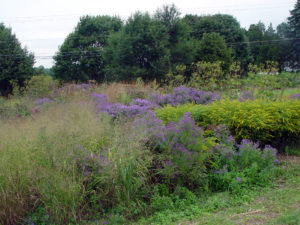
New England aster defines the boundary between switchgrass and fireworks goldenrod.
Wet areas
Wet areas in the landscape provide an excellent gardening opportunity. Swales between property lines or other low areas often stay wet for a day after a rain event. There are many wonderful native plants that thrive in moisture, and wet soils discourage most invasive plants. Most woody plants do not tolerate standing water, so plant the woodies at the periphery of the wet area. Starting with the canopy layer, here are a few good choices.
- Red maple (Acer rubrum)
- Pawpaw (Asimina triloba)
- Ironwood (Carpinus caroliniana,
- Sweetgum (Liquidambar styraciflua)
- Sweetbay magnolia (Magnolia virginiana)
- Sour gum (Nyssa sylvatica)
- Loblolly pine (Pinus taeda)
- Sycamore (Platanus occidentalis)
- Swamp white oak (Quercus bicolor)
- Willow oak (Quercus phellos)
- Bald cypress (Taxodium distichum)
Next, add a shrub layer, which might include:
- Winterberry holly (Ilex verticillata)
- Chokeberry (Aronia arbutifolia)
- Sweet pepperbush (Clethra alnifolia)
- Buttonbush (Cephalanthus occidentalis)
- Witherod viburnum (Viburnum nudum)
All these plants tolerate wet or moist soils, but if water pools regularly, you may need to resort to herbaceous perennials. Some good perennials for moist sites include:
- Marsh mallow (Hibiscus moscheutos)
- Blue vervain (Verbena hastata)
- Cardinal flower (Lobelia cardinalis)
- Great blue lobelia (Lobelia siphilitica)
- New York aster (Symphyotrichum novae-belgii)
- Swamp milkweed (Asclepias incarnata)
- Joe-Pye weed (Eupatorium dubium or E. fistulosum)
This is only a small sample of perennials suitable for moist soils. With the proper planning, you can have a thriving garden that provides many seasons of interest. For example, Sweetbay magnolia has early summer blooms combined with a lovely lemony fragrance; sweet pepperbush blooms in the summer (and has yellow fall color as a bonus); Joe-Pye weed blooms in mid-summer, and marsh mallow, blue vervain, and lobelia all bloom in late summer. In the fall, you can count on purple foliage color from witherod viburnum and red or orange leaves from red maple, sweetgum, and sourgum trees. Finally, the red berries of winterberry holly provide color throughout the winter. Winterberry looks best when displayed against an evergreen background or in combination with a warm-season grass, such as switchgrass (Panicum virgatum), to provide a tan winter backdrop.
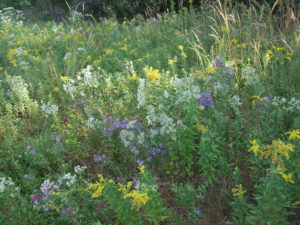
Grasses, asters, goldenrod, and eupatorium flower profusely in this wet swale with little competition from invasive plants.
Dry shade
Dry shade is the classic garden problem situation. Many yards, especially in established neighborhoods, have dry shady areas. When shallow-rooted trees create a shady environment, there is intense competition for sun and moisture. Do not even try to grow lawn grasses in dry shade; they require both light and adequate moisture. In some cases, the best solution for very dry shade is only a layer of mulch or leaf litter. Even with a planted understory, don’t remove all the leaves—they add valuable organic matter.
While most ornamental grasses require full sun, there are a few grasses and grass-like plants that tolerate shade. Crinkled hair grass (Deschampsia flexuosa) and bottle-brush grass (Elymus hystrix) are two grasses that tolerate varying degrees of shade and dry soil. Pennsylvania sedge (Carex pensylvanica) is an excellent ground cover that tolerates very shady, dry sites and will even tolerate periodic mowing.
While most ferns require moist soil, there are a few ferns that will do well in dry shade. Eastern hay-scented fern (Dennstaedtia punctilobula) is so tough that it might become a garden thug under better garden conditions. Interrupted fern (Osmunda claytoniana) and Christmas fern (Polystichum acrostichoides) both tolerate dry conditions. Large masses of Christmas fern are often found growing on well-drained forest slopes. Two shade-loving asters, heart-leaf aster (Symphyotrichum cordifolium) and white wood aster (Eurybia divaricata), thrive in dry shade. However, just like the hay-scented fern, beware of wood aster and its ability to take over your garden under good conditions. The following plants will all tolerate dry conditions and partial shade.
- Hyssop-leaved thoroughwort (Eupatorium hyssopifolium)
- Tall white beardtongue (Penstemon digitalis)
- Bowman’s root (Gillenia trifoliata)
- Wild ginger (Asarum canadense)
- Woodland phlox (Phlox divaricata)
- Large merrybells (Uvularia grandiflora)
- Hairy alumroot (Heuchera villosa)
- Golden groundsel (Packera aurea)
- Yellow trillium (Trillium luteum)
- Jacob’s ladder (Polemonium reptans)
- Bluestem goldenrod (Solidago caesia)
Some non-natives are great performers in dry shade, such as barrenwort (Epimedium sp.), Hakone grass (Hakonechloa macra ‘Aureola’), and lenten rose (Helleborus orientalis). Virginia creeper (Parthenocissus quinquefolia) is a vine that tolerates dry shade and will sprawl across the ground making a perfectly acceptable groundcover. Our native pachysandra—Allegheny pachysandra (Pachysandra procumbens) is another excellent dry shade ground cover.
It is harder to find shrubs that tolerate dry shade. Pinxterbloom azalea (Rhododendron periclymenoides) is a great deciduous azalea with fragrant, white to pale pink flowers that is a must for the dry shade garden. Oakleaf hydrangea (Hydrangea quercifolia) thrive in dry shade. If you want evergreen foliage in your dry shade garden, try Carolina rhododendron (Rhododendron minus).
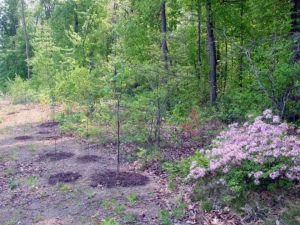
Pinxterbloom azalea in dry woods along the roadside.
Forest Edge
The edge of an eastern deciduous forest often has filtered light and highly organic soil, providing the ideal environment for a diverse complement of plants. Maintaining a healthy forest edge helps protect the rest of the forest from incursion by invasive plants. If you are lucky enough to border an existing forest or have a partially shaded edge on your property, you can create a rich garden in this niche.
On the wood’s edge, shrubs, and trees such as serviceberry (Amelanchier canadensis), spicebush (Lindera benzoin), blackhaw (Viburnum prunifolium), and arrowwood viburnum (V. dentatum) provide richly diverse habitats for birds, insects, and other desirable wildlife. This edge will deliver a pleasing seasonal display when supplemented with showy native shrubs and perennials such as the following:
Shrubs
- Oakleaf hydrangea (Hydrangea quercifolia)
- Sweet pepperbush (Clethra alnifolia)
- Pinxterbloom azalea (Rhododendron periclymenoides)
- Coast azalea (Rhododendron atlanticum)
- American beautyberry (Callicarpa americana)
- Elderberry (Sambucus canadensis)
- Dwarf fothergilla (Fothergilla gardenii)
Perennials
- Foamflower (Tiarella cordifolia)
- Indian pinks (Spigelia marilandica)
- Virginia bluebells (Mertensia virginica)
- Dwarf iris (Iris cristata)
- Thin-leaved sunflower (Helianthus decapetalus)
- Woodland sunflower (Helianthus divaricatus)
Using a few non-invasive exotic plants can complement and expand the artistic character of a naturalistic landscape style. Here are some examples:
- Stinking hellebore (Helleborus foetidus)
- Barrenwort (Epimedium sp.)
- Donkey tail spurge (Euphorbia myrsinites)
- Japanese roof iris (Iris tectorum)
- Korean mum, (Chrysanthemum ‘Sheffield’)
- Chinese beautyberry (Callicarpa dichotoma)
With carefully chosen combinations, it’s easy to create habitat and experience natural beauty in your own backyard.
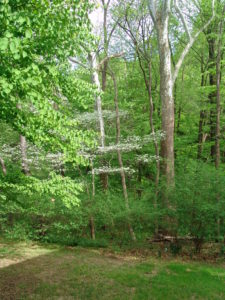
Spring blooming flowering trees like our native flowering dogwoods brighten the forest edge.
Ponds/Stream Edge
Well-planted pond or stream edges can improve ecological conditions and the natural beauty of your property. By overcoming our propensity for neatness along these edges, we can improve water and habitat quality. Plantings can filter nutrients and pollutants that flow from the lawn and impervious surfaces of your landscape. Nurture deep-rooting, shade- and habitat-producing plants to create a more attractive space for desirable fauna and observers of fauna and help make the most of your property’s natural potential.
Many of the same shrubs that excel in wet conditions, such as winterberry, chokeberry, and sweet pepperbush, also thrive at the water’s edge. Some stunning perennial flowers prefer conditions of a riparian edge, such as the following.
- Cardinal flower (Lobelia cardinalis)
- Great blue lobelia (Lobelia. siphilitica)
- Scarlet rosemallow (Hibiscus coccineus)
- Joe-Pye weed ( Eutrochium dubium and E.fistulosum)
- Blue mistflower (Eupatorium coelestinum)
- Blue phlox (Phlox divaricata)
- Bee balm (Monarda cvs such as ‘Raspberry Wine’ and ‘Corl Reef’)
- Sneezeweed (Helenium cv.)
Much of the water’s edge vegetation has a narrow vertical form, such as cattails (Typha angustifolia) and common rush (Juncus effusus). However, several ferns provide a perfect contrast to that vertical form, like interrupted fern (Osmunda claytoniana), ostrich fern (Matteuccia struthiopteris), and lady fern (Athyrium filix-femina).
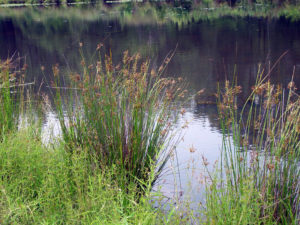
Common rush is an evergreen edge plant with an attractive yellow to tawny-colored flower cluster.
Sunny Slope
Property edges often have sunny slopes—next to the driveway, along the back border, or adjacent to the street. Mowing steep slopes are unnecessary and can be downright dangerous. Depending on the slope size, conditions, and desired aesthetic, choose from a combination of maintenance strategies to eliminate the need to mow. You can spot spray to control undesirable plants or cut back with a string trimmer once or twice a year, creating more of a meadow or an old field aesthetic.
Many flowering plants such as goldenrods (Solidago sp.), thoroughworts (Eupatorium hyssopifolium and E. rotundifolium), milkweed (Asclepias syriaca), Queen Anne’s lace, etc., will volunteer among the little bluestem (Schizachyrium scoparium), broomsedges (Andropogon sp.), prairie dropseed (Sporobolus heterolepis) and other grasses. ‘Plugging’ in a few suitable native perennials can expand the flowering season and interest. Here are some examples.
- Threadleaf blue star (Amsonia hubrichtii)
- Blue star (Amsonia tabernaemontana)
- Butterfly milkweed (Asclepias tuberosa)
- Showy aromatic asters (Symphyotrichum oblongifolium)
- Wild indigos (Baptisia sps.)
- Pink doll’s daisy (Boltonia asteroides ‘Pink Beauty’)
When you stop mowing entirely, early successional woody plants such as eastern red cedar, black cherries or serviceberries will begin to colonize. Discourage undesirable woody and invasive plants by selective removal. Shrubs and trees might also be added, such as red twig dogwood (Cornus sericea), sweet pepperbush (Clethra alnifolia), ninebark (Physocarpus opulifolius), sumacs (Rhus sp.), or bush honeysuckle (Diervilla sessilifolia). You can choose to slightly supplement the ecological succession by adding a few attractive species or replant the entire slope as a naturalistic garden bed, depending on your aesthetic sensitivities. If you prefer a more orderly composition, limit the palette to two or three plants of complementary texture, height, and form.
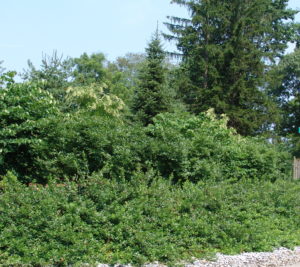
Fragrant sumac makes a dense groundcover on this slope in front of a mixed woody border.
Salt and Sand
Seashore soils can be challenging to plant, but your garden can thrive with careful plant selection and soil preparation. Prepare sandy garden soils with plenty of organic material like composted leaves and grass clippings. The organic matter will help retain soil moisture and provide nutrients. Salt deposited from one-time events, such as flooding with ocean water, will gradually leach out with rainwater. The process can be quickened by flooding the area with fresh (not salt) water. Seashore soils tend to have naturally high salt levels, and the following plants are especially well suited to tolerate this and the drought conditions common on quick-draining sandy soils.
Tough native plants from the dunes of our Atlantic coast include:
- Cape American beachgrass (Ammophila breviligulata ‘Cape’)
- Prickly pear cactus (Opuntia humifusa)
- Adam’s Needle (Yucca filamentosa)
- Northern bayberry (Myrica pensylvanica)
- Groundsel bush (Baccharis halimifolia)
- Eastern red cedar (Juniperus virginiana)
With a little organic material in the soil, you can also grow the following shrubs and perennials:
- Beach rose (Rosa rugosa)
- Beach plum (Prunus maritima),
- American holly (Ilex opaca)
- Threadleaf coreopsis (Coreopsis verticillata)
- Aromatic aster (Symphyotrichum oblongifolium ‘Raydon’s Favorite’ or ‘October Skies’)
- Hyssop-leaved thoroughwort (Eupatorium hyssopifolium)
- Spike gayfeather (Liatris spicata)
- Cut-leaf coneflower (Rudbeckia laciniata ‘Herbstonne’)
- Beach panicgrass (Panicum amarum)
- Switchgrass (Panicum virgatum)
- Seaside goldenrod (Solidago sempervirens)
In wet areas, butterfly milkweed (Asclepias tuberosa) and swamp mallow (Hibiscus moscheutos) are excellent choices that support wildlife and provide attractive mid-summer blooms. For vines, try trumpet vine (Campsis radicans); its orange trumpet-shaped flowers are a feast for hummingbirds, but beware, in ideal conditions, you may need to prune it heavily each winter to keep it in check. Although not native, perennials like hydrangeas, sedums, and cosmos (a reseeding annual) thrive in salty, sandy soils and can brighten seashore landscapes.
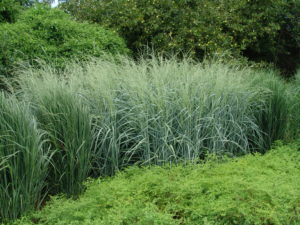
Dewey Blue panicgrass is flanked by Northwind switchgrass and fronted by aromatic aster.
Small Gardens
Modern life and schedules are well suited to small gardens like those accompanying an urban row house or an intensely gardened area on a suburban lot. A smaller garden rewards you with an easier managed and maintained space, plus more time to enjoy that space. With less square footage, it’s easier and less costly to amend your soil, mulch, and water your plants during dry spells.
You’ll want to choose plants in scale with smaller plantings. For trees, this means smaller species or dwarf cultivars. Try sweetbay magnolia (Magnolia virginiana) for the airy, open shaped showy white blooms in June, or serviceberry (Amelanchier canadensis) for a multi-stemmed tree with springtime flowers, summer berries, and red-gold fall color. Eastern redbud (Cercis canadensis) is often grown as a multi-stemmed tree and features eye-catching purple flowers in April and May before its foliage comes out.
In a small garden, valuable vertical space can be used for ornamental vines like Virginia rose (Rosa virginiana) (be sure to choose disease-resistant cultivars) or the long-blooming native coral honeysuckle (Lonicera sempervirens ‘Alabama Crimson.’)
Since a smaller garden also limits the variety of plants you can use, it’s even more important to choose species with long bloom, berry, or leaf color displays. Plan your garden to have interesting aspects in each season. Mid-winter highlights include common winterberry (Ilex verticillata), remarkable for its bright berries, and winter flame dogwood (Cornus sanguinea ‘Winter Flame) with its vibrant orange to red stems. Be sure to include some of the many smaller cultivars of our native evergreens –eastern arborvitae (Thuja occidentalis, dwarf forms) and common and creeping junipers (Juniperus communis var. depressa, J. horizontalis). Oakleaf hydrangea (Hydrangea quercifolia) is a multi-stemmed shrub with a wintertime display of dried flower heads and peeling cinnamon-red bark.
Good perennials for small spaces include:
- White Wake Robin trillium (Trillium grandiflorum)
- Mayapple (Podophyllum peltatum)
- Foamflower (Tiarella cordifolia)
- Creeping phlox (Phlox stolonifera)
- Orange Meadow Brite coneflower (Echinacea ‘Orange Meadow Brite’)
- Speedwell (Veronica spicata)
- Threadleaf blue star (Amsonia hubrichtii)
- Showy stonecrop (Sedum spectabile)
- Aromatic aster (Symphyotrichum oblongifolium)
- Apple blossom yarrow (Achillea taygetea ‘Apple Blossom’)
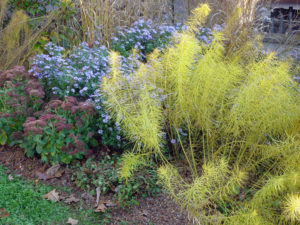
This combination of threadleaf blue star, showy stonecrop and aromatic aster packs a colorful punch in a small space for the fall garden.
For more information on invasive plant alternatives and sustainable landscaping, visit the University of Delaware Extension Publication Sustainable Landscapes | Cooperative Extension.
About the Author
Susan Barton, Ph.D., is an extension specialist and professor in the Plant and Soil Sciences Department at the University of Delaware. She has worked closely for the past 20 years with DelDOT to research and implement new roadside vegetation management strategies. She has also worked with partners to develop the Plants for a Livable Delaware Program, designed to provide alternatives to known invasive plant species and promote sustainable landscaping. She teaches Plants and Human Culture, Farm to Table, Landscape Drawing, Landscape Architecture Symposium, Landscape Management and coordinates the Landscape Architecture/Plant Science Internship. She also works closely with the nursery and landscape industry, writing newsletters, organizing short courses, and conducting horticulture industry expos with the Delaware Nursery and Landscape Association. Susan received the Nursery Extension Award in 1995 from the American Nursery and Landscape Association and the Ratledge Award for service from the University of Delaware in 2007. Susan received her SITES AP certification in summer 2017. In 2021, Susan received the George M. Worrilow award from the College of Agriculture and Natural Resources, given to a college alumnus with exemplary service to agriculture in the state.
***
Each author appearing herein retains original copyright. Right to reproduce or disseminate all material herein, including to Columbia University Library’s CAUSEWAY Project, is otherwise reserved by ELA. Please contact ELA for permission to reprint.
Mention of products is not intended to constitute endorsement. Opinions expressed in this newsletter article do not necessarily represent those of ELA’s directors, staff, or members.

